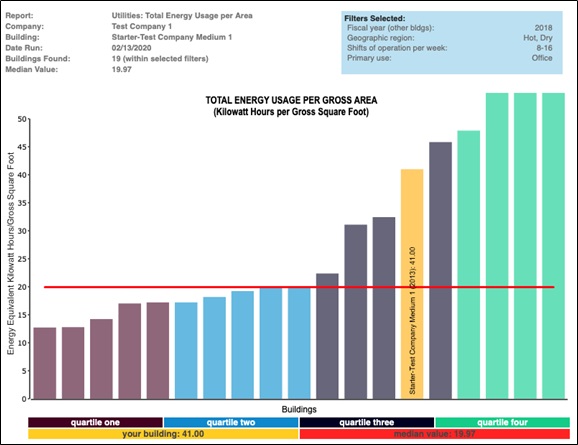March 2020 — In last month’s article, we demonstrated how benchmarking can be used to select best practices that would have the best opportunity to reduce consumption. In this article we will show a few more steps that you can take to show that the implemented best practices work. These tips can be used almost immediately to show progress toward desired objectives and to update management.
Just a little background on our example facility: Our building is a 220,000 SF office facility located in a “hot-dry” climate zone. The total occupancy is 500 FTE employees and it operates with 16 shifts per week.
The energy performance is 41 KWH per GSF. In last month’s article we examined three sets of results, representing the following three filter sets (see Table 1) to carefully determine our building’s relative performance with peers:
| Filter Set | Median KWH/GSF |
1st Quartile KWH/GSF |
Current KWH/GSF |
|
Building Type: Office
|
31 | 18 | Mid Q3 |
| Building Type: Office No. of Shifts: 8-16 |
27 | 16 | Low Q4 |
| Building Type: Office No. of Shifts: 8-16Climate: Hot/Dry |
20 | 16 | Mid Q3 |
Table 1: Filter sets used to determine the most appropriate filters to study energy performance for subject building.
The last filter set in the table above is applied to Figure 1. Here, we see that our building (in yellow) appears in the third performance quartile and is performing significantly worse than buildings in the second quartile, which are (by definition) better than the median, which is shown by the horizontal red line.

Figure 1 – Total energy usage per GSF
Filters: Type of facility (Office) + 8-16 shifts per week + Hot-Dry climate zone
Provided courtesy of FM BENCHMARKING
We then reviewed six of 44 best practices provided by the FM BENCHMARKING tool, to consider where the best opportunities exist. In Figure 2 we have shown the six best practices.
Figure 2 shows the percent of “Utility Best Practices” based on the selected filter set, that were implemented by peers in our building’s quartile (3rd) compared to the percent implemented by the next better quartile (2nd).

Figure 2– Energy Best Practices Based on Cost per Area
Filters: Type of facility (Office) + 8-16 shifts per week + Hot-Dry climate zone
All 44 best practice items will not have the same impact. Some will have significantly more impact depending on how your building is used and the structure of your rates with your electric utility supplier. Let’s look at some of the other best practices for Utilities.
If the utility rate structure has high demand charges, then you would look at best practices that would have an impact on reducing them (not shown in Figure 2):
- UB38 – Demand side management
- UB39 – Gas/thermal driven AC
- UB43 – Operate on-site generators to reduce demand charges
- UB44 – Thermal storage (ice or water)
There are others but UB38 – Demand side management is probably the most significant since you will pay the highest demand you use in a given monthly cycle, even if it only for 15 minutes.
Other utilities may have a relatively low demand charge but a high KWH rate. Here you would be more concerned about reducing the overall consumption. Some best practices that would have a significant impact on overall consumption would be:
- UB02 – Motion sensors in general office space
- UB06 – Ongoing recommissioning at least once per year
- UB11 – Plate and frame heat exchangers to reduce chiller operation when weather permits
- UB32 – CO2 monitoring of make-up air
As you can see, there are many best practices, not all of which will have the greatest impact. Clearly a detailed analysis of the options would be appropriate to have the highest payback.
By looking at the best practices and see what percent of your peers in your filter set have implemented them, both in your performance quartile and the next better one, you will have a good idea of what you should consider doing to improve your building’s performance. By presenting these data together with your cost estimate to implement the recommended best practice along with the savings achieved (as per Figure 1) by those in the next better-performing quartile, you will have all you need to justify this recommendation to your management.